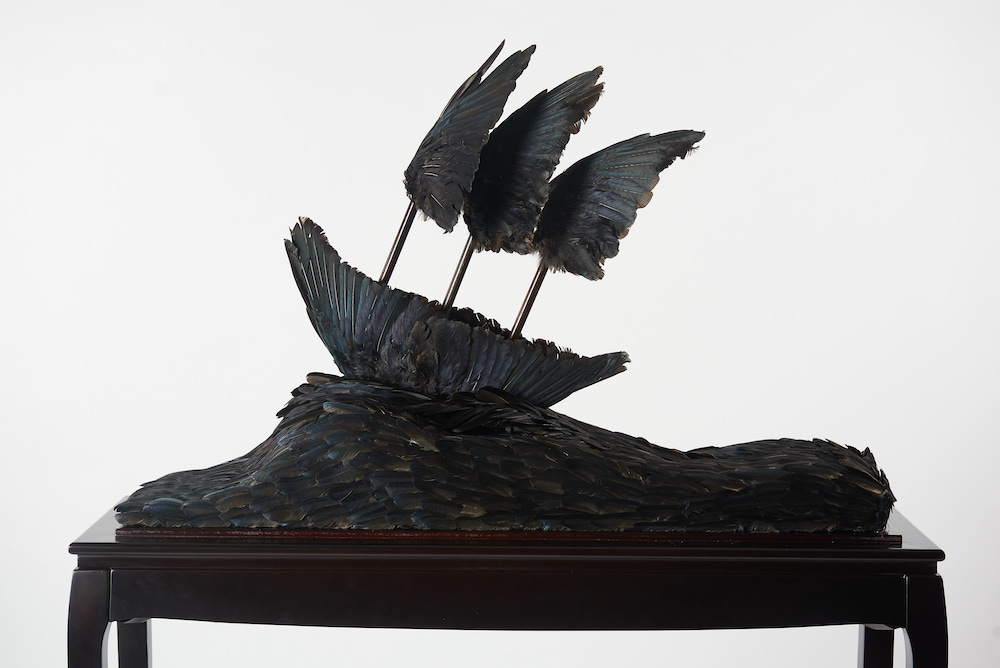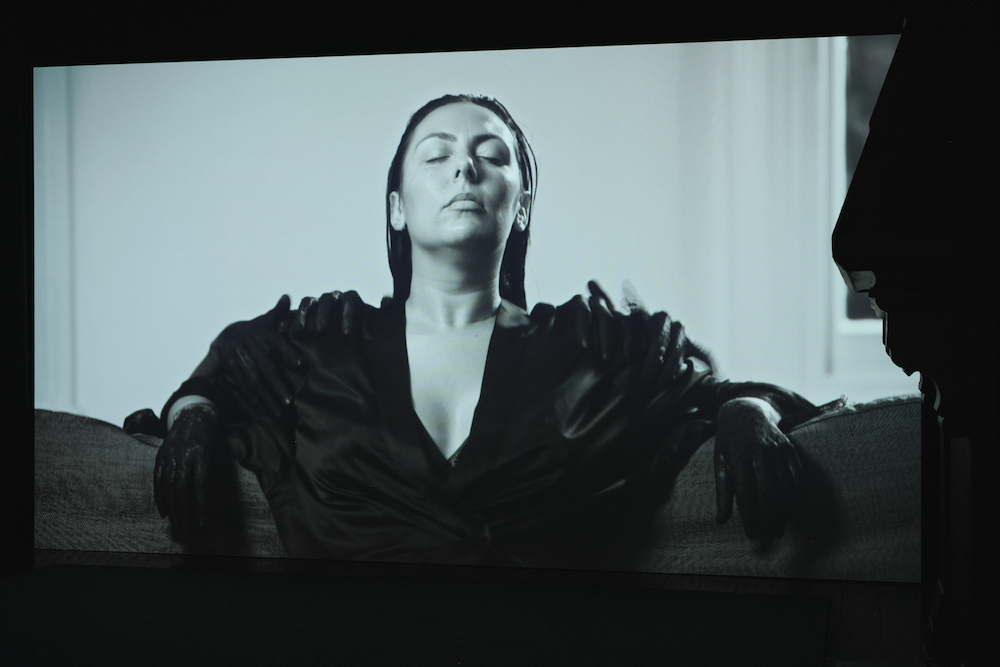Three powerful exhibitions at Fremantle Arts Centre take the viewer to physical and metaphorical horizons, writes Cass Lynch.
Journeys through water, time and truth-telling
1 March 2023
- Reading time • 8 minutesVisual Art
More like this
- This Angel soars, even on one wing
- Power of language written on the walls
- Oh! What an extraordinary experience
Other Horizons, Jasmine Togo-Brisby, Atong Atem and Hayley Millar Baker
Fremantle Arts Centre
Brought together under a single name, Other Horizons comprises three separate exhibitions: Abyss by Australian South Sea Islander artist Jasmine Togo-Brisby, Banksia by Naarm (Melbourne)-based South Sudanese artist Atong Atem, and Nyctinasty by Gunditjmara and Djabwurrung artist Hayley Millar Baker. Curated by Glenn Iseger-Pilkington, this trio of independent projects by women of colour is united by a theme of journeys through water, time and truth-telling.
Togo-Brisby’s ship of souls is marooned in time, unchanged by Australia’s ignorance of its history of slavery, calcifying in its horror as a memorial to stolen futures.
In Fremantle Art Centre’s main gallery, 369 prone plaster Vanuatu cultural figures gaze sightlessly from the wooden floor, arranged to suggest the outline of a ship. Togo-Brisby’s As Above So Below (2022) is a new work commissioned for Other Horizons and is an extraordinary impression of the conditions of those trafficked during the Pacific Slave Trade. In the 1800s and 1900s upwards of 60,000 people were kidnapped or coerced off islands in the Pacific region and enslaved or placed under indentured servitude in colonial plantations, many in Australia.
The plaster figures lie in a mandala-like configuration reflecting the schematics of a British slaver’s ship from the 1700s. Mandalas often represent paths to God – if not God itself – and there is a perversion of sacred geometry at play here, where mathematical design was employed by colonial masters to fill the ship with as many people as possible.
The bone-white pallor of the figures and the stillness in the gallery suggests a funeral held at a mass grave, where cultural people were bleached of colour and life have been laid to rest. Togo-Brisby’s ship of souls is marooned in time, unchanged by Australia’s ignorance of its history of slavery, calcifying in its horror as a memorial to stolen futures.

A slave ship is transformed into feathers in Togo-Brisby’s Absented Presence series (2022). Black feathers are an unmistakable reference to “Blackbirding” – the colloquial term for the theft of people for the Pacific Slave Trade in the 19th and early 20th century.
In this nautical sculpture a ship made of black feathers crests a feathery wave, its three crow wing sails lifting the plumed keel as it catches the breeze. Here the slave ship and ocean that carried it are transformed through their barbarous acts to become “black birds” themselves, wearing their true natures on the outside.
Moving water opens Atong Atem’s film Banksia (2021); a woman emerges from a river and finds herself among tall mirrors driven into the banks. Mirrors speak to representation and identity, and Atem’s film asks questions about who is represented within the frame of history, and how that frame might lack authenticity in representing the migrant experience.
Following the river scene, the film features young people dressed as Western upper-class professionals in opulent settings, then sitting for portrait photography in front of static backgrounds, then reclining like subjects in Greek or Roman classical art. The film is highly stylised and muted, as if Atem is presenting the viewer with a dream sequence that we must make sense of within our own lived experience.

The mood changes in the final scene; the young women of the film are now singing and dancing in the traditional attire of South Sudanese culture. It is colourful and joyous, and the viewer realises that we are hearing human voices in the film for the first time. The chroma and vibrancy of this final scene parallels the technicolour portraits that Atem is famous for. Banksia doesn’t offer answers, it instead presents layers of questions about the migration narrative that is presented in archives, news media and popular culture.

Hayley Millar Baker’s Nyctinasty (2021) is an atmospheric video artwork in which the artist is presented conducting an unnamed ceremony at night. The film is a series of long, stationary shots in black and white, where Millar Baker takes burnt material from a smoking dish on the veranda and places it in a mortar bowl, then taking time to grind the dark mixture into a paste.
Millar Baker is known for her black and white photo collages, exploring the colonial and cultural histories of her Country via high contrast landscapes made hyperreal through mirroring and sharp focus. Nyctinasty is a new exploration of the monochromatic palette, where the removal of colour heightens the senses and bring the textures and sound of the black paste to the foreground.
The artist on screen takes the pounded mixture from the mortar bowl and proceeds to cover her hands in the dark granular paste. She reclines against the couch and the soundtrack suggests tension, but there is no fear. Four ghoulish hands then emerge from behind her, slicked with the same dark paste from the ceremony, stretched fingers gleaming like galaxies. They clasp her shoulders and the film ends.
Nyctinasty is a fascinating new beat for Millar Baker; she has done hard work in exposing colonial crimes in previous works, and now ceremony is having a moment to occupy the centre of her practice.
Via smoke, water, plumage and plaster these three women artists explore horizons both interior and exterior. Come walk in their wake.
Pictured top: Jasmine Togo-Brisby, ‘As above so below’, 2022, installation of plaster forms. Commissioned for Other Horizons by Fremantle Arts Centre in association with Perth Festival. Supported by visual arts partner Wesfarmers Arts. Photo: Rebecca Mansell
Other Horizons continues at Fremantle Arts Centre until 23 April 2023, as part of Perth Festival.
Like what you're reading? Support Seesaw.






